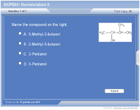Organic Nomenclature II
| Topic Review on "Title": |
IUPAC Nomenclature for Alcohols, Ethers, Aldehydes, Ketones, Carboxylic Acids and Amines
The longest continuous carbon chain is the parent compound. Circle the carbon chain to aid in identifying the parent compound. Number the chain so that the C-O bond has the lowest possible number. From the alkyl prefixes, use Aanol@ for alcohols and Aane@ for ethers. For ethers, the longest carbon chain is the parent compound and use Aoxy@ for the substituent group. Give the location of the C-O bond with a number. From the alkyl prefixes, use Aanal@ for aldehydes and Aanone@ for ketones. From the alkyl prefixes, use Aanoic acid@ for carboxylic acids and Aanamine@ for amines. For amines, give the location of the attachment of the N to the parent amine and number the groups attached to N. Give the location of each substituent with a number. Give the location of each substituent with a number. Use numerical prefixes if more than one identical group is present. Alphabetize the groups, ignoring all numerical prefixes. Examples are given
IUPAC Nomenclature for Carboxylic Acid Derivatives
An ester is named as an alkyl alkanoate. An anhydride is named as an alkanoic alkanoic anhydride. An acid halide is named as alkanoyl halide. An amide is named as an alkanamide. Any group attached to the N is numbered as AN.@ Examples are given
Common Nomenclature for Alcohols, Ethers, and Ketones
Use common prefixes, if needed. An alcohol is named as an alkyl alcohol. An ether is named as an alkyl alkyl ether. Alphabetize the groups. A ketone is named as an alkyl alkyl ketone. Alphabetize the groups. An amine is named with the alkyl groups first, then Aamine.@ Alphabetize the groups. Examples are given.
|
| Rapid Study Kit for "Title": |
| Flash Movie |
Flash Game |
Flash Card |
| Core Concept Tutorial |
Problem Solving Drill |
Review Cheat Sheet |
 |
 |
 |
|
| "Title" Tutorial Summary : |
Two types of nomenclature are used in organic chemistry B IUPAC and common. Before naming any organic compounds, learn the first ten alkyl prefixes. Then follow the IUPAC rules for naming alcohols, ethers, aldehydes, ketones, and carboxylic acids. The carboxylic acid derivatives have their own rules for nomenclature. The rules for the common nomenclature for alcohols, ethers, and ketones are described.
|
| Tutorial Features: |
This tutorial provides the comprehensive coverage of the chapter with easy introduction and simple illustration. It features:
- Concept map showing interconnections of new concepts in this tutorial and those previously introduced.
- Definition slides introduce terms as they are needed.
- Visual representation of concepts.
- Use of colors to emphasis points.
- Easy-to-follow animations of stated rules of nomenclature.
- Examples worked out step-by-step throughout the tutorial.
- A concise summary is given at the conclusion of the tutorial.
|
| "Title" Topic List: |
Two Types of Nomenclature
- IUPAC Nomenclature
- Common Nomenclature
IUPAC Nomenclature
- Rules for Alcohols, Ethers, Aldehydes, Ketones, Carboxylic Acids, and Amines
- Rules for Carboxylic Acid Derivatives
|
See all 24 lessons in college chemistry, including concept tutorials, problem drills and cheat sheets:
Teach Yourself Organic Chemistry Visually in 24 Hours |



